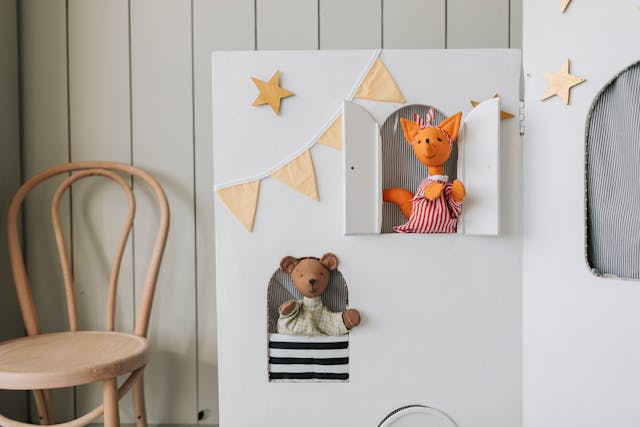Puppet shows for co-production
Save your old socks, add googly eyes, and watch children explore their expereinces.

Save your old socks, add googly eyes, and watch children explore their expereinces.

Range of puppets including:People puppets of different ages/ethnicities Animal puppets (often less threatening) Fantasy characters Blank puppets that can be decorated
Portable puppet theater or screen
Props and backdrops
Recording equipment (if permitted)
Visual supports and schedules
Feedback capture tools
Set up in a quiet, familiar space
Ensure good lighting but avoid fluorescent lights
Create a separate calm space
Arrange seating to accommodate mobility needs
Position the puppet theater at accessible height
Ensure ventilation (consider puppet material allergies)
Visual choice boards for puppet selection
Story structure templates
Communication aids specific to participants
Visual emotional cards
Timer or time indicators
Break cards
Use visual schedule to explain session
Allow exploration of puppets and space
Demonstrate puppet handling
Establish communication signals
Set basic ground rules together
Simple puppet greeting exercises
Copying movements and sounds
Basic emotion expression with puppets
Turn-taking practice
Voice experimentation
Present relevant scenario (e.g., doctor's visit)
Allow participants to choose puppets
Support role-play of current experiences
Encourage "what if" alternatives
Document suggestions made
Use puppets to walk through service steps
Identify challenges and positive moments
Act out ideal scenarios
Create solution scenes
Record key points raised
Create puppet personalities
Develop backstories
Express needs and preferences
Build confidence in expression
Note recurring themes
Offer multiple ways to engage
Operating puppets
Suggesting storylines
Creating voices
Moving props
Directing others
Allow observation time
Accept all forms of communication
Use pause points for processing time
Follow participant's lead
Small groups (3-4 maximum)
Clear turn-taking systems
Visual timers for shares
Support cards for quiet members
Break-out options
Designate a note-taker
Use simple rating systems
Take photos (with permission)
Record key quotes
Create visual summaries
Offer weighted or textured puppets
Provide fidget alternatives
Consider sound sensitivity
Use natural lighting
Allow movement breaks
Use AAC with puppets
Include sign language
Incorporate symbols
Allow typed responses
Support physical prompting if needed
Short scene structure
Regular movement breaks
Change activities frequently
Build-in sensory rewards
Flexible ending points
Summarize key themes
Create visual record
Share outcomes appropriately
Maintain confidentiality
Track impact on services
Gather views on process
Check understanding
Plan next steps
Share how input will be used
Celebrate contributions
Start with observation roles
Use familiar stories
Incorporate special interests
Build confidence gradually
Celebrate small steps
Have comfort objects available
Use calm down strategies
Provide movement breaks
Allow story distance
Support processing time
Have backup puppets ready
Maintain simple props
Keep spare resources
Plan alternative activities
Maintain flexibility
Increased participation
Emotional engagement
Repeated attendance
Growing confidence
Actionable feedback
Maintain appropriate boundaries
Watch for disclosure signals
Know reporting procedures
Ensure consent for recording
Protect confidentiality
Always have alternative communication methods ready
Follow the participant's pace and interests
Build in plenty of processing time
Celebrate all forms of contribution
Keep notes on what works for each participant
Be prepared to adapt in the moment
Focus on the process, not the performance
Maintain a supportive, non-judgmental atmosphere